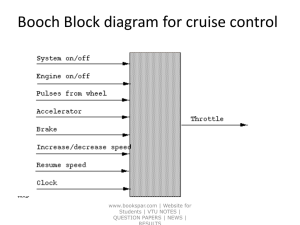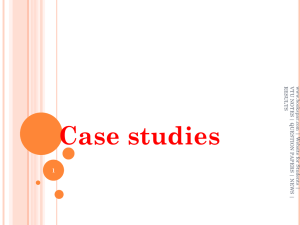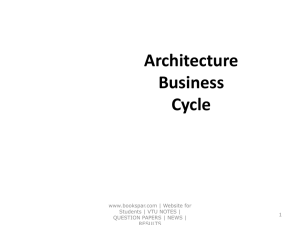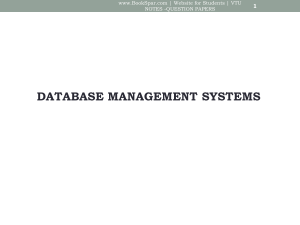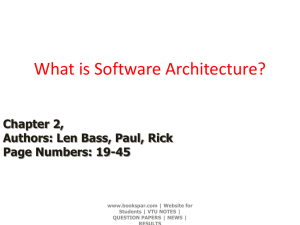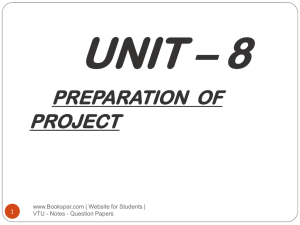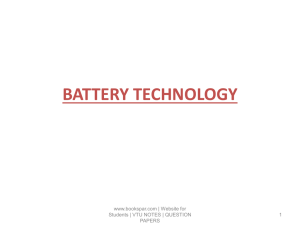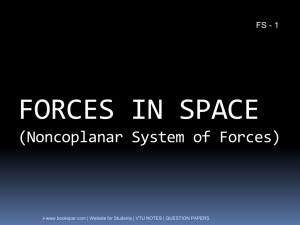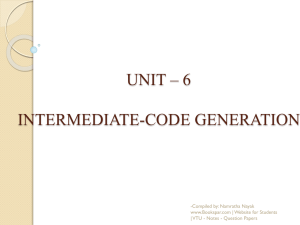SS-SIC-by-Leland-L-Beck
advertisement
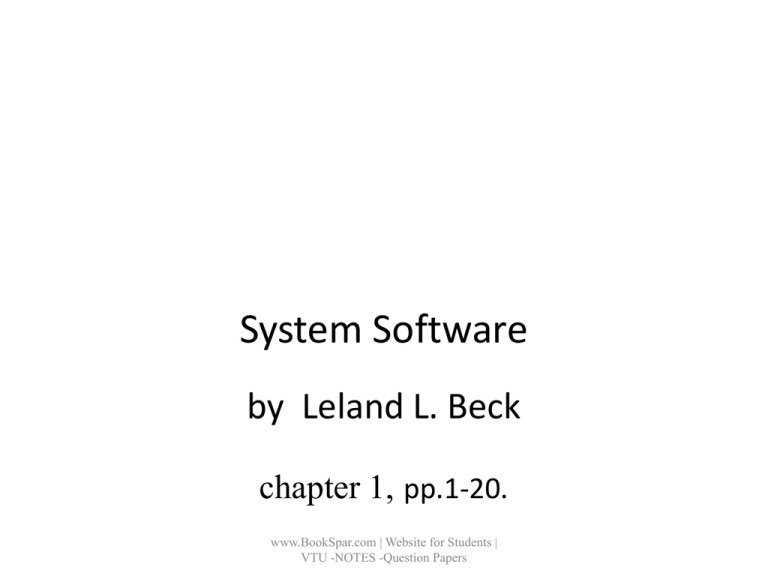
System Software
by Leland L. Beck
chapter 1, pp.1-20.
www.BookSpar.com | Website for Students |
VTU -NOTES -Question Papers
Outline of Chapter 1
• System Software and Machine Architecture
• The Simplified Instructional Computer (SIC)
• Traditional (CISC) Machines
– Complex Instruction Set Computers
• RISC Machines
– Reduced Instruction Set Computers
www.BookSpar.com | Website for Students |
VTU -NOTES -Question Papers
System Software vs. Machine Architecture
• Machine dependent
– The most important characteristic in which most
system software differ from application software
– e.g. assembler translate mnemonic instructions into machine
code
– e.g. compilers must generate machine language code
• Machine independent
– There are aspects of system software that do not directly
depend upon the type of computing system
– e.g. general design and logic of an assembler
– e.g. code optimization techniques
www.BookSpar.com | Website for Students |
VTU -NOTES -Question Papers
The Simplified Instructional Computer (SIC)
• SIC is a hypothetical computer that includes
the hardware features most often found on
real machines
• Two versions of SIC
– standard model
– extension version
www.BookSpar.com | Website for Students |
VTU -NOTES -Question Papers
SIC Machine Architecture (1/5)
• Memory
– 215 bytes in the computer memory
– 3 consecutive bytes form a word
– 8-bit bytes
• Registers
Mnemonic Number Special use
A
0
Accumulator; used for arithmetic operations
X
1
Index register; used for addressing
L
2
Linkage register; JSUB
PC
8
Program counter
SW
9
Status word, including CC
www.BookSpar.com | Website for Students |
VTU -NOTES -Question Papers
SIC Machine Architecture (2/5)
• Data Formats
– Integers are stored as 24-bit binary numbers; 2’s
complement representation is used for negative
values
– No floating-point hardware
• Instruction Formats
opcode (8)
x
address (15)
• Addressing Modes
Mode
Direct
Indexed
Indication
Target address calculation
x=0
TA=address
x=1
TA=address+(X)
www.BookSpar.com
| Website for Students |
VTU -NOTES -Question Papers
SIC Machine Architecture (3/5)
• Instruction Set
– load and store: LDA, LDX, STA, STX, etc.
– integer arithmetic operations: ADD, SUB, MUL, DIV,
etc.
• All arithmetic operations involve register A and a word in
memory, with the result being left in the register
– comparison: COMP
• COMP compares the value in register A with a word in
memory, this instruction sets a condition code CC to
indicate the result
www.BookSpar.com | Website for Students |
VTU -NOTES -Question Papers
SIC Machine Architecture (4/5)
• Instruction Set
– conditional jump instructions: JLT, JEQ, JGT
• these instructions test the setting of CC and jump
accordingly
– subroutine linkage: JSUB, RSUB
• JSUB jumps to the subroutine, placing the return address in
register L
• RSUB returns by jumping to the address contained in register L
www.BookSpar.com | Website for Students |
VTU -NOTES -Question Papers
SIC Machine Architecture (5/5)
• Input and Output
– Input and output are performed by transferring 1
byte at a time to or from the rightmost 8 bits of
register A
– The Test Device (TD) instruction tests whether the
addressed device is ready to send or receive a
byte of data
– Read Data (RD)
– Write Data (WD)
www.BookSpar.com | Website for Students |
VTU -NOTES -Question Papers
SIC Programming Examples
•
•
•
•
•
Data movement Fig. 1.2
Arithmetic operation Fig. 1.3
Looping and indexing Fig. 1.4, Fig. 1.5
Input and output Fig. 1.6
Subroutine call Fig. 1.7
www.BookSpar.com | Website for Students |
VTU -NOTES -Question Papers
SIC Programming Examples (Fig 1.2)
-- Data movement
ALPHA
FIVE
CHARZ
C1
RESW1
WORD
5
BYTE
C’Z’
RESB
1
.
.
LDA
FIVE
STA
ALPHA
LDCH CHARZ
STCH
C1
• No memory-memory move
instruction
• 3-byte word:
– LDA, STA, LDL, STL, LDX,
STX
• 1-byte:
– LDCH, STCH
• Storage definition
– WORD, RESW
– BYTE, RESB
(a)
www.BookSpar.com | Website for Students |
VTU -NOTES -Question Papers
SIC Programming Examples (Cont.)
• All arithmetic operations are performed using
register A, with the result being left in register
A.
BETA=ALPHA+INCR-ONE
DELTA=GAMMA+INCR-ONE
www.BookSpar.com | Website for Students |
VTU -NOTES -Question Papers
SIC Programming Example
-- Arithmetic operation (Fig 1.3)
BETA=ALPHA+INCR-ONE
DELTA=GAMMA+INCR-ONE
www.BookSpar.com | Website for Students |
VTU -NOTES -Question Papers
SIC Programming Example
-- Looping and indexing (Fig. 1.4)
www.BookSpar.com | Website for Students |
VTU -NOTES -Question Papers
SIC Programming Example
-- Looping and indexing (Fig. 1.5)
• Arithmetic
– Arithmetic operations are performed using register A, with the
result being left in register A
• Looping (TIX)
– (X)=(X)+1
– compare with operand
– set CC
GAMMA[I]=ALPHA[I]+BETA[I]
I=0 to| Website
100for Students |
www.BookSpar.com
VTU -NOTES -Question Papers
SIC/XE Machine Architecture (1/4)
• Memory
– 220 bytes in the computer memory
• More Registers
Mnemonic Number Special use
B
3
Base register; used for addressing
S
4
General working register
T
5
General working register
F
6
Floating-point acumulator (48bits)
www.BookSpar.com | Website for Students |
VTU -NOTES -Question Papers
SIC/XE Machine Architecture (2/4)
• Data Formats
– Floating-point data type: frac*2(exp-1024)
• frac: 0~1
• exp: 0~2047
s exponent (11)
fraction (36)
• Instruction Formats
Format 1
op(8)
Format 2
op(8)
r1(4)
Format 3
op(6)
e=0
n I xbp e
Format 4
op(6)
e=1
n I xbpe
address (20)
www.BookSpar.com | Website for Students |
VTU -NOTES -Question Papers
r2(4)
disp(12)
SIC/XE Machine Architecture (3/4)
• How to compute TA?
Mode
Base relative
PC-relative
Indication
b=1, p=0
b=0, p=1
Target address calculation
TA=(B)+disp (0<=disp<=4095)
TA=(PC)+disp (-2048<=disp<=2047)
operand
(TA)
(TA)
Direct
Indexed
b=0, p=0
x=1
TA=disp (format 3) or address (format 4)
TA=TA+(X)
(TA)
(TA)
• How the target address is used?
Mode
Indication
immediate addressingi=1, n=0
indirect addressing i=0, n=1
operand value
TA
((TA))
– Note: Indexingi=0,
cannot
be used
with immediate or indirect addressing
n=0
SIC instruction (all end with 00)
modes
i=1, n=1
SIC/XE instruction
simple addressing
www.BookSpar.com | Website for Students |
VTU -NOTES -Question Papers
Example of SIC/XE instructions
and addressing modes
www.BookSpar.com | Website for Students |
VTU -NOTES -Question Papers
www.BookSpar.com | Website for Students |
VTU -NOTES -Question Papers
SIC/XE Machine Architecture (4/4)
• Instruction Set
–
–
–
–
–
new registers: LDB, STB, etc.
floating-point arithmetic: ADDF, SUBF, MULF, DIVF
register move: RMO
register-register arithmetic: ADDR, SUBR, MULR, DIVR
supervisor call: SVC
• generates an interrupt for OS (Chap 6)
• Input/Output
– SIO, TIO, HIO: start, test, halt the operation of I/O device
(Chap 6)
www.BookSpar.com | Website for Students |
VTU -NOTES -Question Papers
SIC/XE Programming Examples (Fig 1.2)
ALPHA RESW 1
FIVE
WORD5
CHARZ BYTE
C1
RESB
.
.
LDA
STA
LDCH CHARZ
STCH
ALPHA
C1
C’Z’
1
FIVE
ALPHA
RESW 1
RESB 1
.
.
.
LDA
STA
LDA
STCH C1
C1
(b)
(a)
www.BookSpar.com | Website for Students |
VTU -NOTES -Question Papers
#5
ALPHA
#90
SIC/XE Programming Example
-- Looping and Indexing Example (Fig 1.4)
www.BookSpar.com | Website for Students |
VTU -NOTES -Question Papers
SIC/XE Programming Example
-- Looping and indexing (Fig 1.5)
www.BookSpar.com | Website for Students |
VTU -NOTES -Question Papers
SIC/XE Programming Example
• data movement
– #: immediate addressing for SIC/XE
• arithmetic
– ADDR S,X
• Looping (TIXR T)
– (X)=(X)+1
– compare with register specified
– set CC
• COMPR X,T
www.BookSpar.com | Website for Students |
VTU -NOTES -Question Papers
SIC Programming Example
-- Sample Input and Output (Fig 1.6)
www.BookSpar.com | Website for Students |
VTU -NOTES -Question Papers
Homework #1
• Write a sequence of instructions for SIC/XE to
set ALPHA equal to 4*BETA-9. Assume that
ALPHA and BETA are defined as in Fig. 1.3 (b)
• Write a sequence of instructions for SIC to set
ALPHA equal to the integer portion of
BETAGAMMA. Assume that ALPHA and BETA
are defined as in Fig. 1.3(a)
www.BookSpar.com | Website for Students |
VTU -NOTES -Question Papers
Homework #2
• Please write a program for SIC/XE that
contains routines. The routines read records
from an input device (identified with device
code F1) and copies them to an output device
(code 05). This main routine calls subroutine
RDREC to read a record into a buffer and
subroutine ERREC to write the record from the
buffer to the output device. Each subroutine
must transfer the record one character at a
time because the only I/O instructions
available are RD and WD.
www.BookSpar.com | Website for Students |
VTU -NOTES -Question Papers
Homework #2
• Program copy {
•
save return address;
• cloop: call subroutine RDREC to read one record;
•
if length(record)=0 {
•
call subroutine WRREC to write EOF;
•
} else {
•
call subroutine WRREC to write one record;
•
goto cloop;
•
}
•
load return address
•
return to caller
•
}
www.BookSpar.com | Website for Students |
VTU -NOTES -Question Papers
Homework #2 (Cont.)
EOR:
Subroutine RDREC {
character x‘00’
clear A, X register to 0;
rloop: read character from input device to A
register
if not EOR {
store character into buffer[X];
X++;
if X < maximum length
goto rloop;
}
store X to length(record);
return
}
www.BookSpar.com | Website for Students |
VTU -NOTES -Question Papers
Homework #2 (Cont.)
• Subroutine WDREC {
•
clear X register to 0;
• wloop: get character from buffer[X]
•
write character from X to output device
•
X++;
•
if X < length(record)
•
goto wloop;
•
return
• }
www.BookSpar.com | Website for Students |
VTU -NOTES -Question Papers
www.BookSpar.com | Website for Students |
VTU -NOTES -Question Papers
